Translate this page into:
Improving the dispersion of SWNT in epoxy resin through a simple Multi-Stage method
⁎Corresponding author at: Department of Aerospace Engineering, Space Research Institute, Malek-Ashtar University of Technology, Tehran, Iran. mahdishayanmehr@mut.ac.ir (Mahdi ShayanMehr)
-
Received: ,
Accepted: ,
This article was originally published by Elsevier and was migrated to Scientific Scholar after the change of Publisher.
Peer review under responsibility of King Saud University.
Abstract
This paper presents a new, univariate and improved Multi-Stage approach for dispersing of nanoparticles as well as nanotubes (CNTs) in polymeric resin. Unlike other old methods, the proposed improved technique is not dependent on various parameters and it is safer than old methods. This Multi-Stage approach includes functionalization of CNTs, mechanical dispersion and ultra-sonication (bath and probe). The quality of dispersion obtained by the proposed method, unlike the probe sonication method, is not affected by different variables such as frequency, cross-section and suspension's temperature. Because during the process, all these parameters are kept constant and linked to the time of process (Univariate system). In the planned tactic, the time of process is determined by a visual test in macro scale.
In the next, in order to verify the presented method, Scanning electron microscopy (SEM) and viscosity tests were used. These tests were employed to examine and compare the quality of Single-wall carbon nanotubes (SWNT) distribution. This comparison was between the new presented approach and one of the known conventional methods (dispersion of functionalized nanotube via Ultra-sonic Probe). Also before these tests, FT-IR test was carryout for investigation of functionalized carbon nanotubes.
The comparison between the results of the new proposed model and applied traditional method showed that the output quality achieved by the new method not only is not lower than the quality achieved by the traditional method but also sometimes is preferable. In addition, for validation, mechanical bending tests on samples made by the presented method showed that the proposed approach improves the mechanical properties of the nanocomposite. This increment was consistent with the results of previous researches that were based on the traditional method. Also, the proposed method was used for dispersing of another nanoparticle named Graphene Oxide, and the accuracy of the proposed method was re-confirmed. Finally, transmission electron microscopy (TEM) was used to show the full dispersion of SWNT based on the new proposed method.
Keywords
Multi-Stage method
Carbon nanotube
Epoxy resin
Dispersion
Functionalizing
Sonication
Mechanical properties
1 Introduction
Carbon nanotubes (CNTs) are increasingly attracting scientific and industrial interest by virtue of their outstanding characteristics (Chen et al., 2007). Among reinforcing fillers, carbon nanotubes are currently attractive because of their excellent mechanical, thermal and electrical properties (Kueseng and Sae-oui, 2013).
On the other hand, Epoxy resins have been widely used in practical applications such as adhesives, construction materials, composites, laminates and coatings owing to their excellent mechanical properties, low cost, ease of processing, good adhesion to many substrates, and good chemical resistance (Chen et al., 2007).
In this regard, some researchers have been focused on the mechanical behavior of CNT polymer nanocomposites, by studying the interphase region between CNTs and polymer. The performance of a CNT/polymer nanocomposite is dependent upon CNTs distribution and interactions between CNTs and polymer (Ma et al., 2010).
Many different techniques including mechanical dispersion, functionalization of CNTs and sonication have been used for dispersion of CNTs in polymers (Pizzutto et al., 2010).
Mechanical dispersion is an important technique for the distribution of nanotubes. This technique included Calendering (Gojny, et al., 2004; Thostenson and Chou, 2006), Stirring and extrusion (Sandler et al., 1999; Schmid and Klingenberg, 2000) and Ball milling (Li et al., 2007).
Functionalization of CNTs is a chemical treatment for dispersing of nanotubes. Chemical functionalization is based on the covalent linkage of functional entities onto the nanotube's carbon scaffold (Mickelson et al., 1998; Kelly et al., 1999). The van der Waals interactions are the important factor to load transfer across the CNT and matrix (Jamal-Omidi et al., 2015a,b). Some researchers improved the interphase by functionalizing the nanotubes (Hirsch, 2002; Balasubramanian and Burghard, 2005).
The mentioned methods can be used for dispersion, but these methods cannot disperse CNTs perfectly. Many researchers indicated that Ultra-sonication is an effective method to disperse CNTs in liquids (Ma et al., 2010). Two main group of sonication are used. In the first group probe sonication is utilized (Zhu et al., 2003; Suave et al., 2009; Lu et al., 1996) and in the next, the bath sonication is used (Park et al., 2002; Khan et al., 2007; Aziz et al., 2012).
Researchers have frequently used bath sonication for dispersing CNTs in organic solvents such as methyl ethyl ketone (MEK) (Park et al., 2002; Khan et al., 2007), water (Aziz et al., 2012) and also in polymers (Ma et al., 2010). However, it has been reported that bath sonication is not adequate for proper dispersion of nanotubes. It can lead to the breakdown of larger bundles but individualize CNTs (Sui and Wagner, 2009; Liao et al., 2004).
Probe sonication, on the other hand, has been consistently mentioned as an efficient method to separate CNTs from bundles (Grossiord et al., 2005). In probe/horn sonication the energy from the wide base is focused on the tip, thus giving the probe high intensity (Ma et al., 2010). So if polymer solution is subjected to irradiation by the probe, because of high-intensity ultrasonic waves, main-chain scission of polymer chains occur (Tabata et al., 1980; Kim and Lee, 2005). In addition, probe sonicator, transfers energy efficiently and this leads to shortening of nanotubes (Grossiord, 2007).
Based on the literature reviews, it has been observed that mechanical dispersion, functionalization and bath sonication are not able to disperse the CNTs in polymers alone. Also, Probe sonication is used for dispersion in the most current research, but using this technique, some scissions occur for polymeric chains and similarly CNTs full length may be lost. Thus it can be seen that none of these methods disperse nanotubes safely and perfectly. Therefore a proposed approach, named Multi-Stage method, is presented to reach a fully dispersed suspension. By this technique, in the first stage, the SWNTs are functionalized; this mater can help to reach a good dispersion in future steps. In the next, ultrasonic probe sonication is used to disperse SWNT bundles. This method is an effective approach for dispersing procedure, but it breaks the polymeric chains and has a bad effect on the length of CNTs. Therefore, this process is only used to disperse the CNTs in the solvent for a short period of time to avoid such bad mentioned effects. This stage makes an approximate distribution of the functionalized nanotubes in the solvent. Lastly, in the next step, both bath sonication and mechanical stirring are utilized to reach fully dispersed CNTs in Resin.
2 Experimental
In this section after introducing the materials, the experimental processes for dispersion of carbon nanotube in the epoxy resin are presented via the new improved Multi-Stage method and traditional one.
2.1 Materials
Single-wall carbon nanotubes are supplied by US Research Nanomaterials, Inc., USA. The diameters of these CNTs are in the range of 1–2 nm, their purity is >95%, and the length is some micrometres. The polymeric matrix consisted of diglycidyl ether of bisphenol A epoxy resin (ML-523 Mokarrar Inc., Iran) and polyamine hardener (HA-14 Mokarrar Inc., Iran). The solvent used is Tetrahydrofuran (THF), from Merck & Co., Inc.
2.2 Process of Multi-Stage method for dispersion of SWNT in epoxy resin
In this section, the process of the new Multi-Stage method for dispersion of SWNT in Epoxy Resin is presented. This approach includes three main stages. These stages are described in the next parts and the schematic of the process is shown in Fig. 1.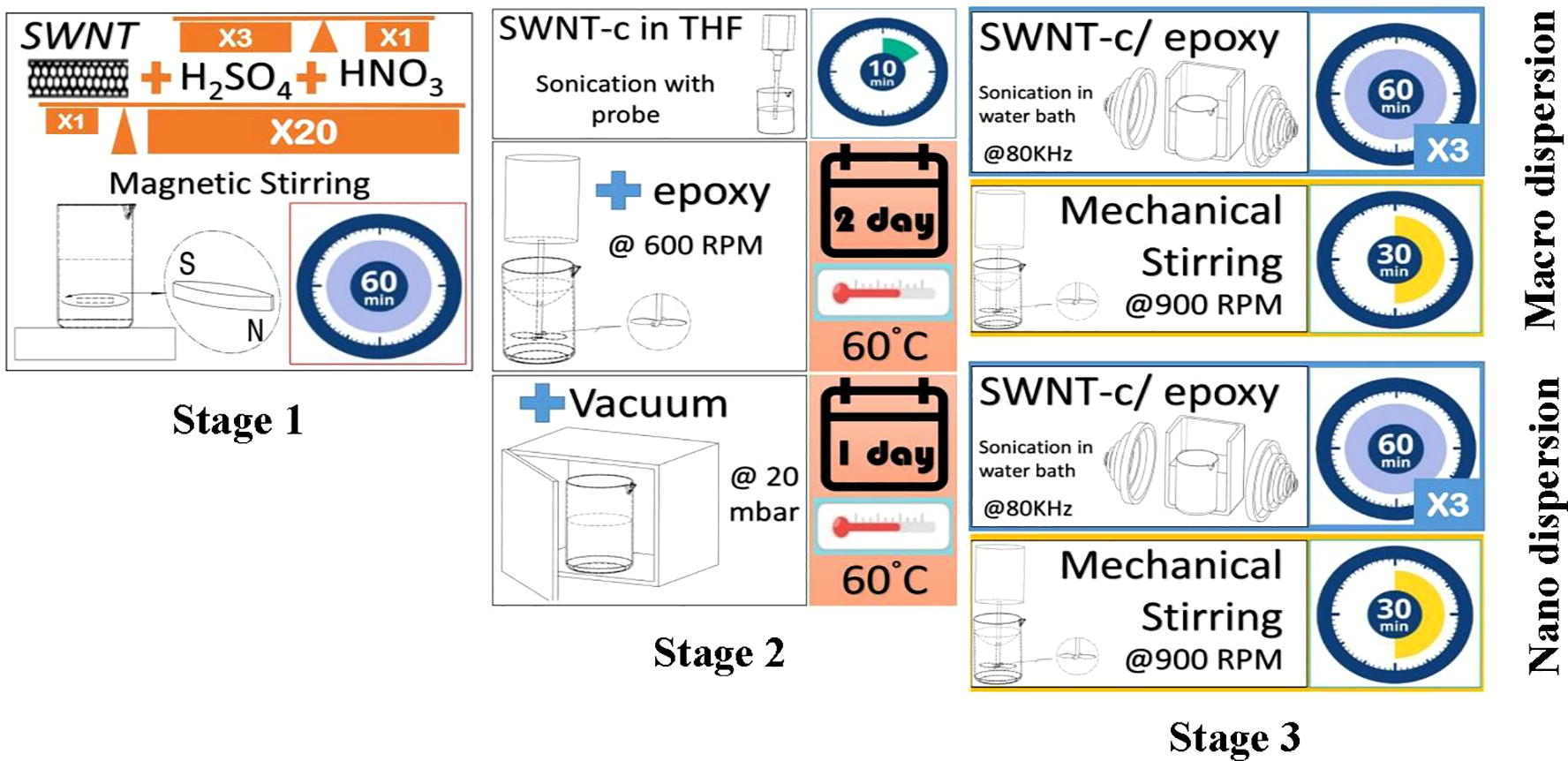
Schematic of proposed Multi-Stage method for dispersion of nanoparticles.
2.2.1 First stage – preparation of carboxylated single-walled carbon nanotubes (SWCNT-c)
At the first stage, in order to prepare carboxylated single-walled carbon nanotube, a certain amount of concentrated 3:1 H2SO4/HNO3 with weight ratio 20:1, relative to the SWCNT is selected. The high weight ratio of SWCNT and H2SO4/HNO3 (20:1) is selected to accelerate the oxidizing of SWNTs. So in this research, one hour is selected for the acid treatment time. Short-time acid treatment is generally preferred for SWNTs to keep the full length with fewer surface defects (Zhu et al., 2003). After that, the solution is extensively washed with 2 L of deionized Water (six times). A pH detector is used each time to control the PH of the solvent. Finally, the acid-treated nanotubes are dried in the oven for 48 h at 70 °C (Zhu et al., 2003).
2.2.2 Second stage – preparation of SWNT-c/Solvent
In this stage, at the first step, SWNTs are suspended to a solvent. In this regards, a certain amount of SWNT-c (0.10 weight percentage (wt%) relative to the epoxy) is added in THF (20 wt%, in relation to the epoxy) under mechanical mixing (900 rpm). After completing this step, for each 20 ml suspension, 10 min high probe-sonication at 165 W of power is carried out for preparation of highly dispersed suspension (Suave et al., 2009). In the next, the suspension (CNT/solvent) is mixed with epoxy resin using a mechanical stirring for 2 days at 60 °C (600 rpm). Finally, the mixture is degassed in a vacuum oven (MEMERT) at 20 mbar and 60 °C for 1 day to remove the solvent.
2.2.3 Third stage –preparation of SWNT-c/epoxy nanocomposites
As mentioned in the literature review, the mechanical stirring and bath sonication alone are not able to disperse the nanotube completely (Sui and Wagner, 2009), so the combination of these two techniques is used in this stage.
In this process for reaching to a well-dispersed sample, in macro scale, a visual test is utilized. Several samples are selected during the sonication process. When the sample reached to a well-dispersed state in visual test, this step is completed (well-dispersed sample in macro scale). Well-dispersed sample is a model that there is no visible particle in it and the mixture is homogeny in macro scale. Two Different types of dispersion in macro scale are shown in Fig. 2.
Dispersion of SWNTs in Macro Scale- (a) Bad dispersion/(b) Good dispersion.
Based on the numerous experimental tests in this research, this concept is proved that by the same sonication (in time and frequency) after macro dispersion, the well-dispersed of model in nano scale can be reached. In this study, in case of SWNT in Epoxy Resin, a well-dispersed suspension in macro scale is prepared by 2 times sonication and mechanical stirring. After that, by another 2 times sonication and mechanical stirring a fully dispersed model in nano scale is prepared. Note that the mechanical stirring (30 min – 900 RPM) is used after each 3 h bath sonication. The schematic process of sonication base on the proposed Multi-Stage method, for SWNT-c in epoxy resin, is presented in Fig. 3.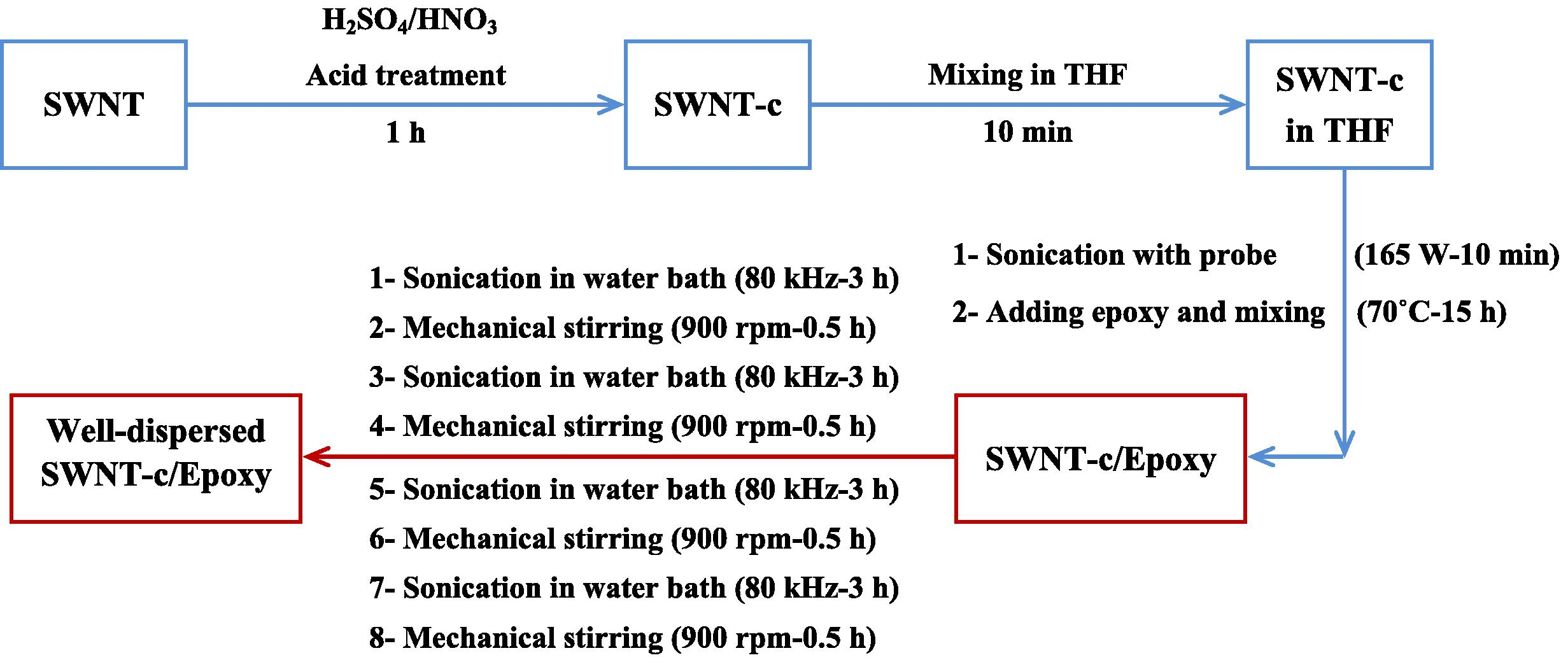
Process of sonication base on the proposed Multi-Stage method for SWNT-c in epoxy resin.
2.3 Process of traditional method for dispersion of SWNT in epoxy resin
In traditional method, after preparation of SWNT-c (Section 2.2.1.) and SWNT-c/Solvent (Section 2.2.2.), probe sonication is used for dispersion of CNTs at 165 W for 15 min, when the volume of SWNT-c/epoxy suspension is 20 ml, (Suave et al., 2009).
3 Results and discussion
According to the previous sections, it is observed that the probe sonication is a common and effective technique for dispersion of nanotubes. The process of this method depends on several parameters that can affect the dispersion quality. These parameters include sonication power, tip size, suspension volume, weight fraction of nanoparticles, suspension viscosity and suspension temperature (Ahir, et al., 2008). It should be also noted that the probe sonication can be lead to scission on polymeric chains and shortening of CNTs (Tabata et al., 1980; Kim and Lee, 2005). Because of the dependence of probe sonication to several parameters and its deficiencies, here a new method was presented to avoid the breaking the polymeric chain/shortening of nanotubes and simultaneous reaching a well-dispersion of nanotubes. In most of the researches, according to the type of nanoparticle and resin, only the frequency and sonication time are reported. Where this information is obtained based on trial and error. Also some parameters such as the suspension volume and temperature are not reported (Zhu et al., 2003; Suave et al., 2009). So there is not a comprehensive approach for new researchers.
Parameters affecting the bath sonication include the cross-sectional area of the suspension, the sonicator frequency, the sonication time, nanoparticle weight fraction, viscosity of mixture and suspension temperature.
In bath sonication the temperature of the suspension remains almost constant and it can be easily controlled.
In this paper to keep constant the parameters such as frequency, cross section (area) and temperature of suspension, a comprehensive approach is presented for dispersion procedures.
The cross section of suspension is defined based on the Eq. (1). The temperature is kept at 35–40 °C and frequency at 80 kHz.
Weight fraction of nanoparticle and viscosity of the resin are two other parameters that affect the sonication process, which are related to time. So, the bath sonication process becomes a function of a single variable “
” (time), and the sonication time can be determined as follows:
The effective parameter in sonication is presented in Fig. 4, also, the fixed value are given in this figure. Based on this arrange, in the proposed method, the bath sonication is a univariate process that is only related to time.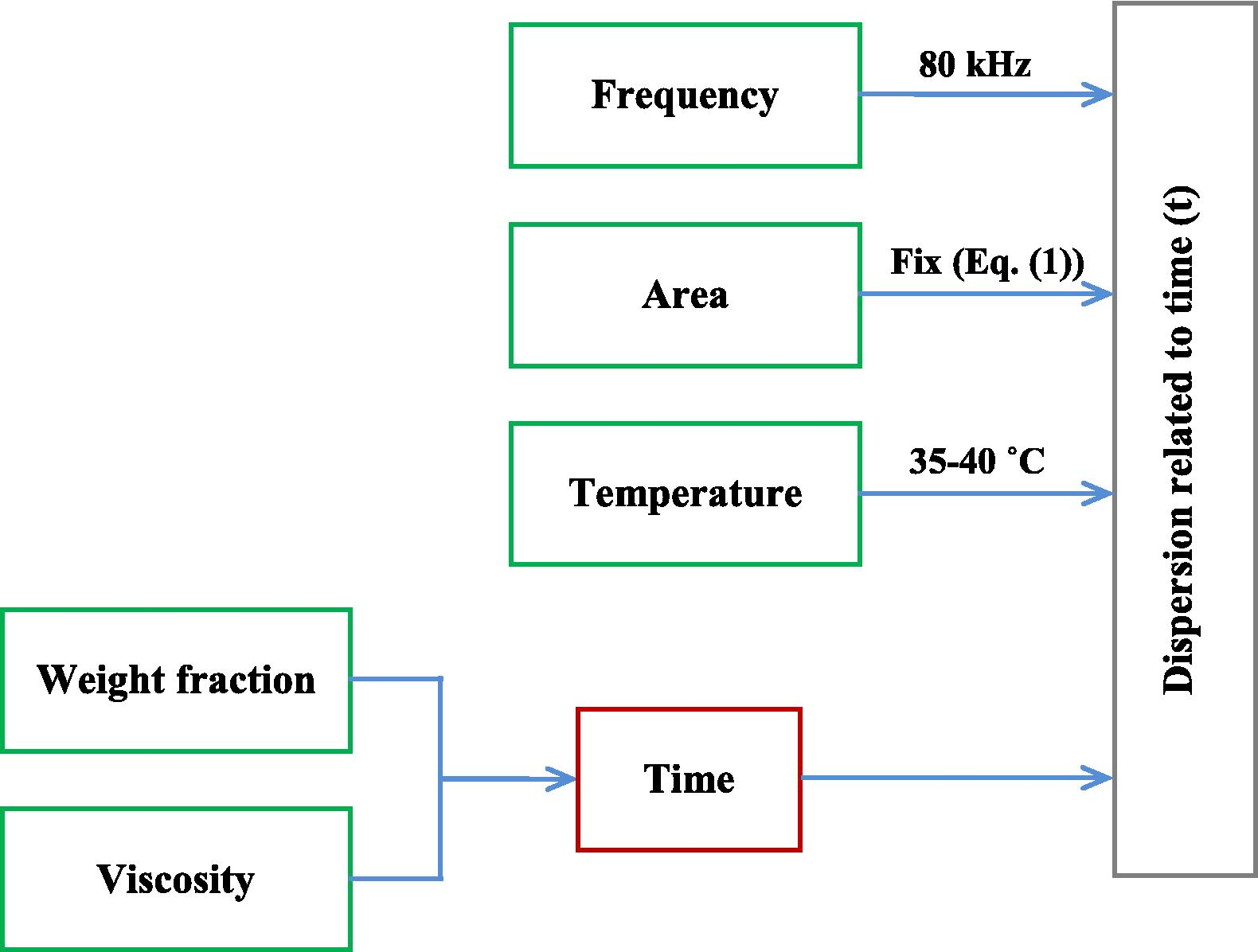
Effective parameter on bath sonication.
After presenting the dispersion procedures, some experimental results are presented for control and evaluation of quality and efficiency of the proposed Multi-Stage approach.
3.1 FT-IR spectra test
In this section, in the first place, the FT-IR spectra (Fourier transform infrared spectroscopy) of SWNT-c is discussed. The carboxylic groups remain on the surface of SWNTs are detected by this test. The result of IR test is shown in Fig. 5. This result shows that the sidewalls of the nanotubes in the SWNT-COOH derivative are covalently modified. The broad band at 3428 cm−1 is due to the hydroxyl groups of —COOH, the band at 1739 cm−1 could be assigned to the C⚌O stretching of acid groups (—COOH). The bands at 2847 and 2921 cm−1 are assigned to the C—H stretching vibrations.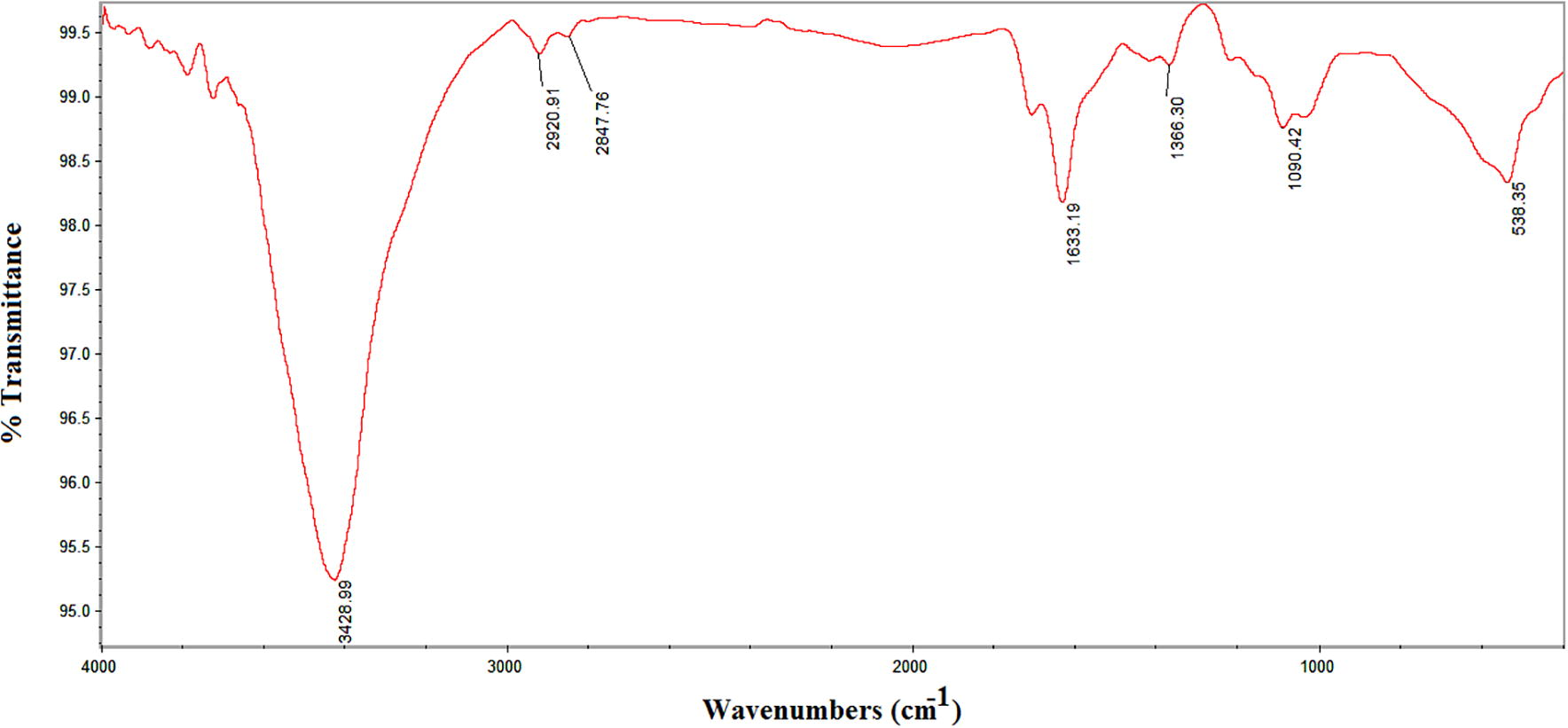
IR spectrum of functionalized nanotubes.
3.2 SEM test
The results of the inspection of the SWNT-c dispersion in the resin are carried out using SEM in this section, Fig. 6. These images indicate that the dispersion of SWNT-c by proposed method (Multi-Stage method) is the same as traditional results. Fig. 6(a) shows SEM image of carbon nanotube treated with the probe, which indicates the break and shortened carbon nanotubes, but when carbon nanotubes are treated under the presented new method (Fig. 6(b)), longer carbon nanotubes are observed suggesting the lower breakage.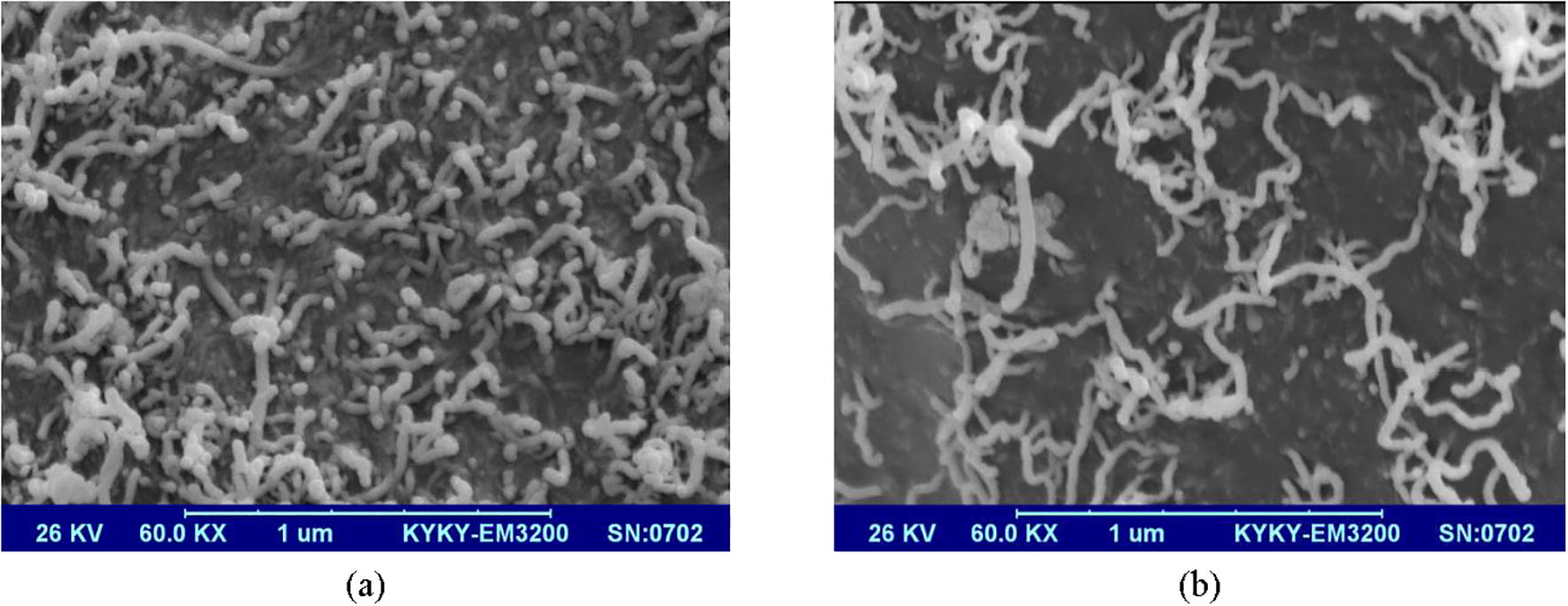
SEM images of the SWNTs dispersion in epoxy based on (a) Traditional method with probe and (b) Proposed Multi-Stage method.
3.3 Viscosity test
To examine the dispersion quality in nano phase, the viscosity of suspension is investigated at different times for traditional method and the proposed method. For this test, the Brookfield Viscometer apparatus is used. It should be noted that increase in the viscosity improves the distribution as a result (Shokrieh et al., 2015).
At the first, to verify the proposed method, viscosity test is applied for SWNT-c/epoxy (0.1 wt%) base on the two different routes, Fig. 7.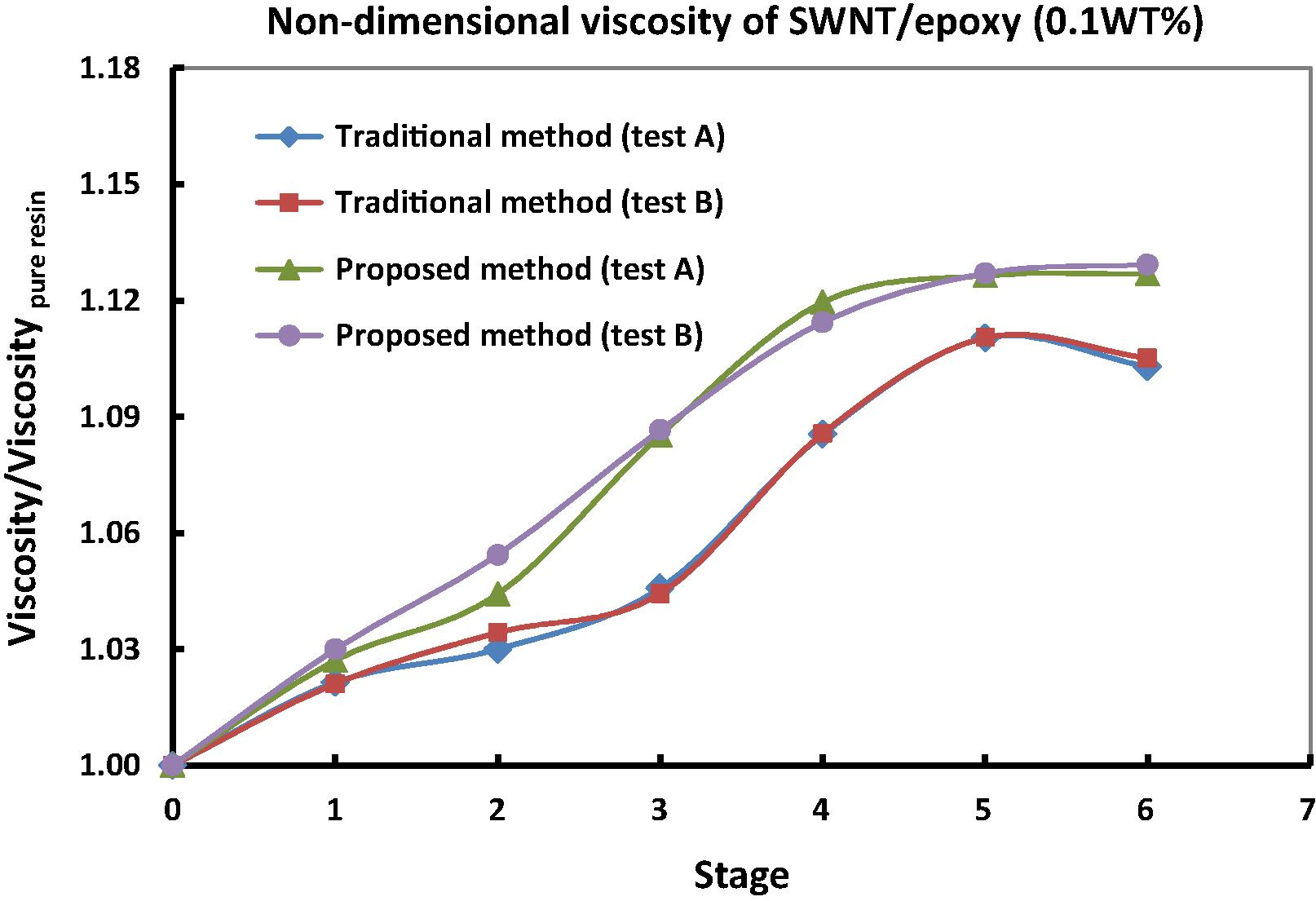
Results of viscosity test for SWNT/epoxy (0.1 wt%).
According to the Fig. 7, it is observed that for the traditional method, the viscosity of the suspension primarily increases during the sonication process and then decreases by passing the sonication's time. While in case of the Multi-Stage method, the viscosity steadily increases and then flattens out at the fix level. In addition, the results comparison shows that, in case of the new method, the final amount of suspension's viscosity is more than traditional ones.
Next, to verify and reassess the efficacy of the proposed method, the process of viscosity testing for SWNT/epoxy (0.25 wt%) and Graphene Oxide (GO)/epoxy (0.1 wt% & 0.25 wt%) are performed. The tests results are presented in Fig. 9. Base on Fig. 8, the similar trends for different tests demonstrated that this technique can be used for different kinds and weight fractions of nanoparticles.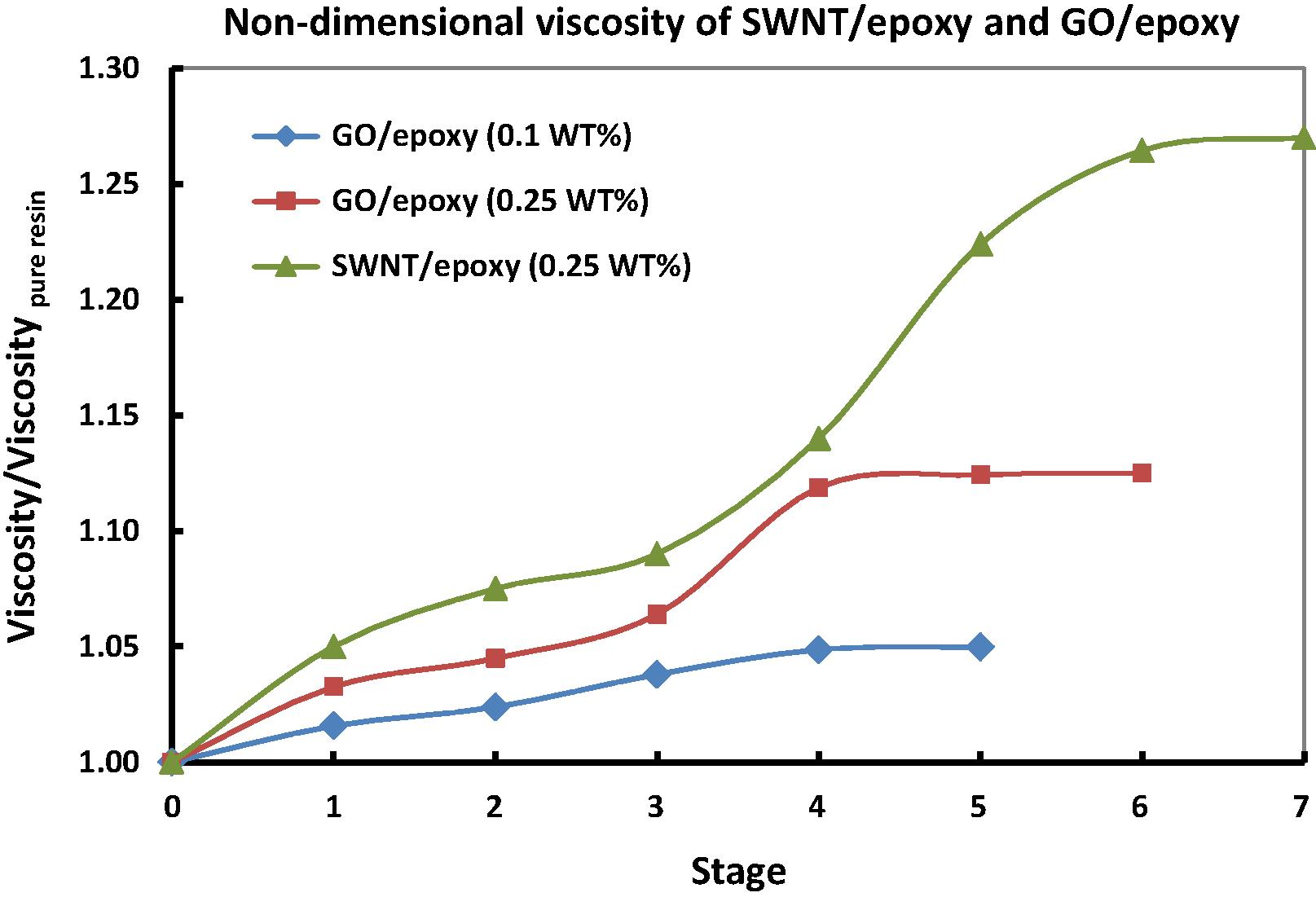
Results of viscosity test for SWNT/epoxy (0.25 wt%) and Go/epoxy (0.1 wt% & 0.25 wt%) based on Multi-Stage method.
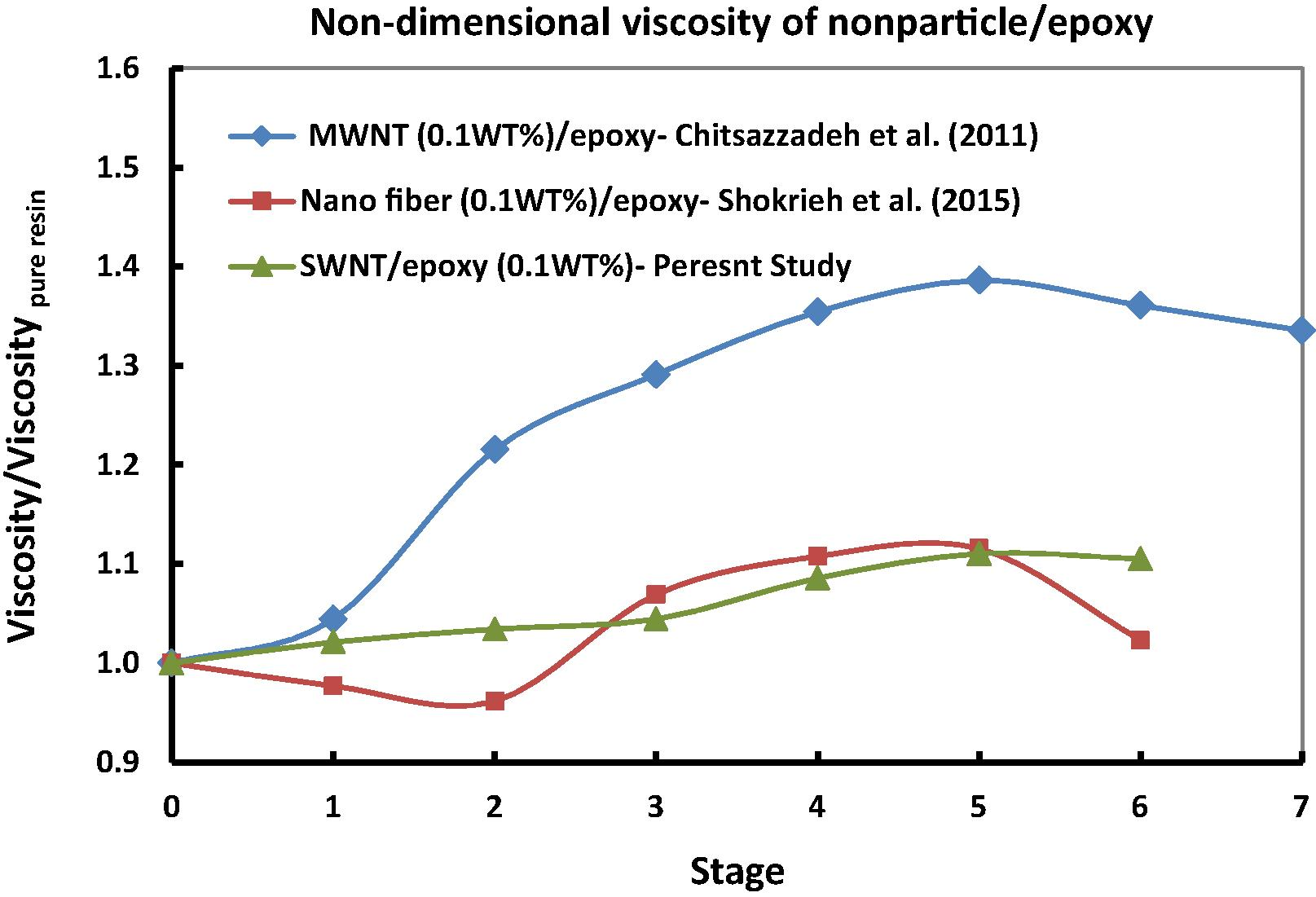
Results of viscosity test based on probe sonication method.
For validation of results, the trends of viscosity for previous researches are compared with the present results), Fig. 9. Researchers of these studies dispersed different nanoparticles in polymeric resins with probe sonicator (traditional method. The results show similar trends for all tests that these trends include an increasing domain and decreasing part. Note that description of the horizontal axis of Figs. 7–9 is presented in Table 1.
Stage No.
Probe sonication method
Multi-Stage method
Present study
Chitsazzadeh et al. (2011)
Shokrieh et al. (2015)
Present study
Time (min)
Time (min)
Energy (kJ/g)
Time (h)
1
5
2
1
10
2
8
4
2
20
3
10
6
3
30
4
13
8
4
40
5
15
10
5
50
6
17
12
6
60
7
–
14
7
–
3.4 Mechanical bending test
In this section, a mechanical bending test is carried out in order to check the efficiency of the Multi-Stage method and validation of the results. The sample models for this test are made by pure resin and the mixture of epoxy resin and SWNT, Fig. 10.models are rectangular beams with 350 mm in length, 25 mm in width and 1 mm in thickness.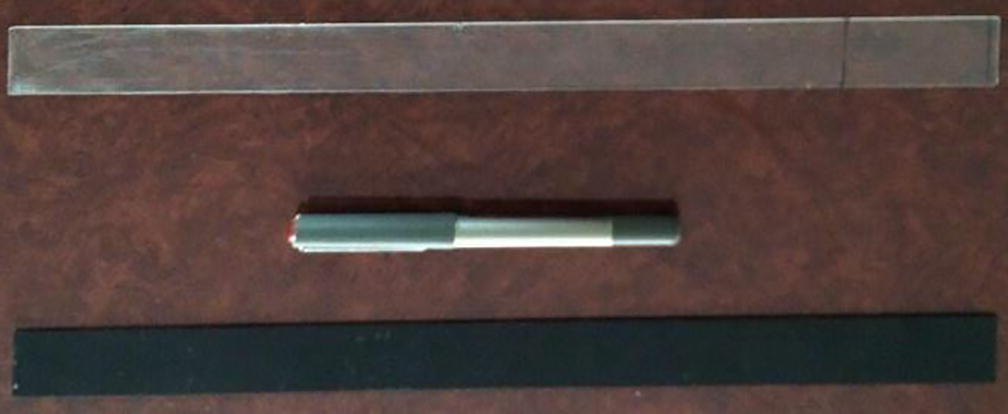
Typical SWNT-c/epoxy (0.1 wt%) and pure epoxy resin test samples.
The testing set-up has been prepared on the basis of the cantilever beam where it is fixed at one end and free to move vertically at the other, Fig. 11, and the calculated values for Young's modulus of samples is extracted and compared.
Schematic test set-up for static loading of cantilever beam.
The Young's modulus of a cantilever beam is considered as follows,
The results of the mechanical test for pure resin and SWNT-c/epoxy are shown in Fig. 12.these results show that the adding of SWNTs base on the proposed method has been improved the mechanical properties of the pure resin. Also, the Improvement percentage in Young's modulus for nanocomposites containing 0.1 wt% SWNT is compared with the other references, Table 2. In this comparison, the present result is based on the new improved method and the other references had dispersed the CNTs by traditional method (Probe Sonication). The rates of Increase in Young's modulus show that output quality achieved by the new method not only is not lower than the quality achieved by the traditional method but also sometimes is preferable than the old method.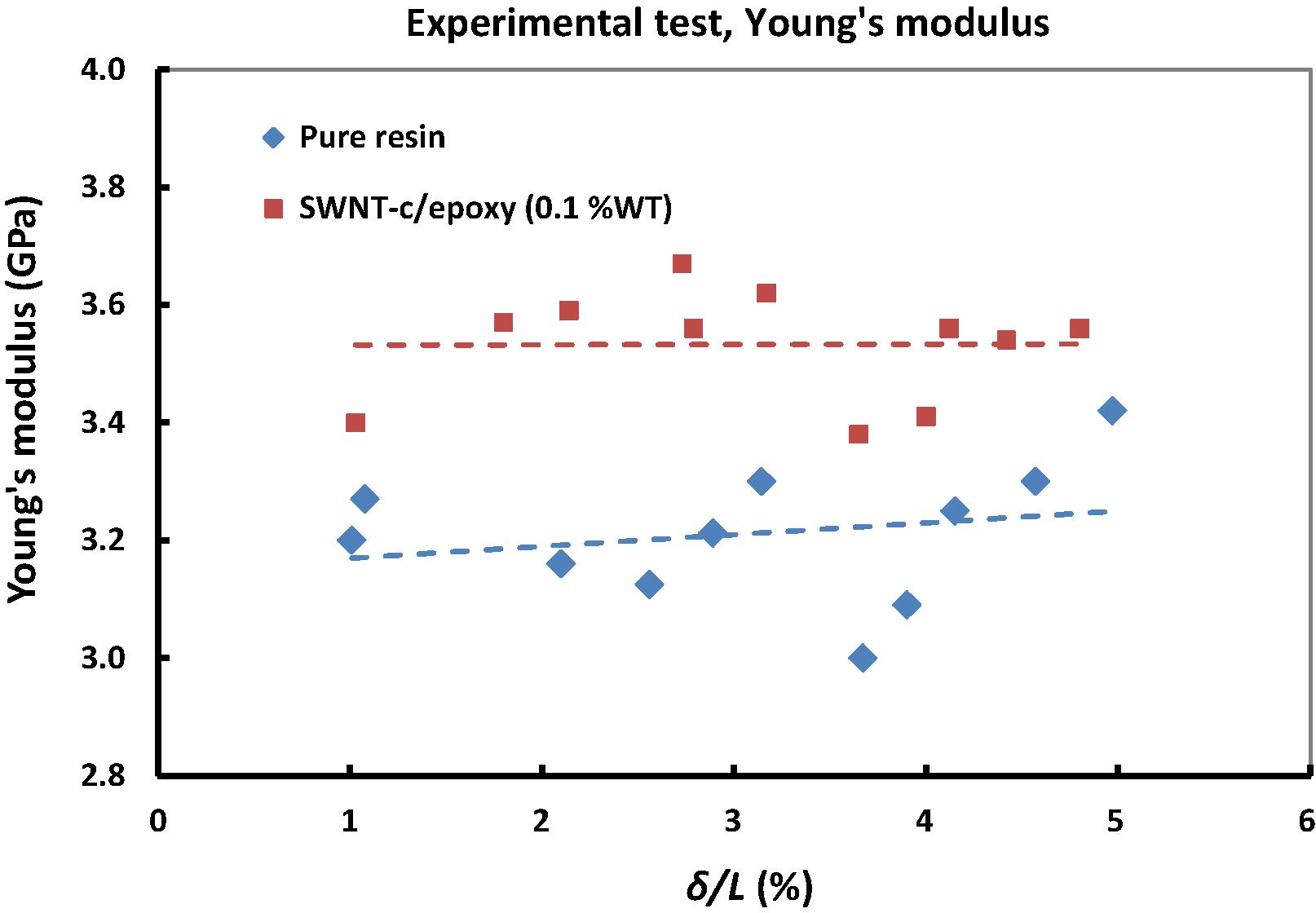
The Young's modulus results for pure epoxy resin and SWNT-c/epoxy (0.1 wt%) samples.
Presented Multi-Stage method
Suave, et al., (2009)
Watters, et al., (2015)
10%
10%
8.4%
3.5 TEM test
In this section, TEM is used to investigate the dispersion status of SWNT based on the proposed multistage method. Fig. 13 depicts the TEM micrograph of dispersed particles. Obviously, fully dispersion of SWNTs can be seen.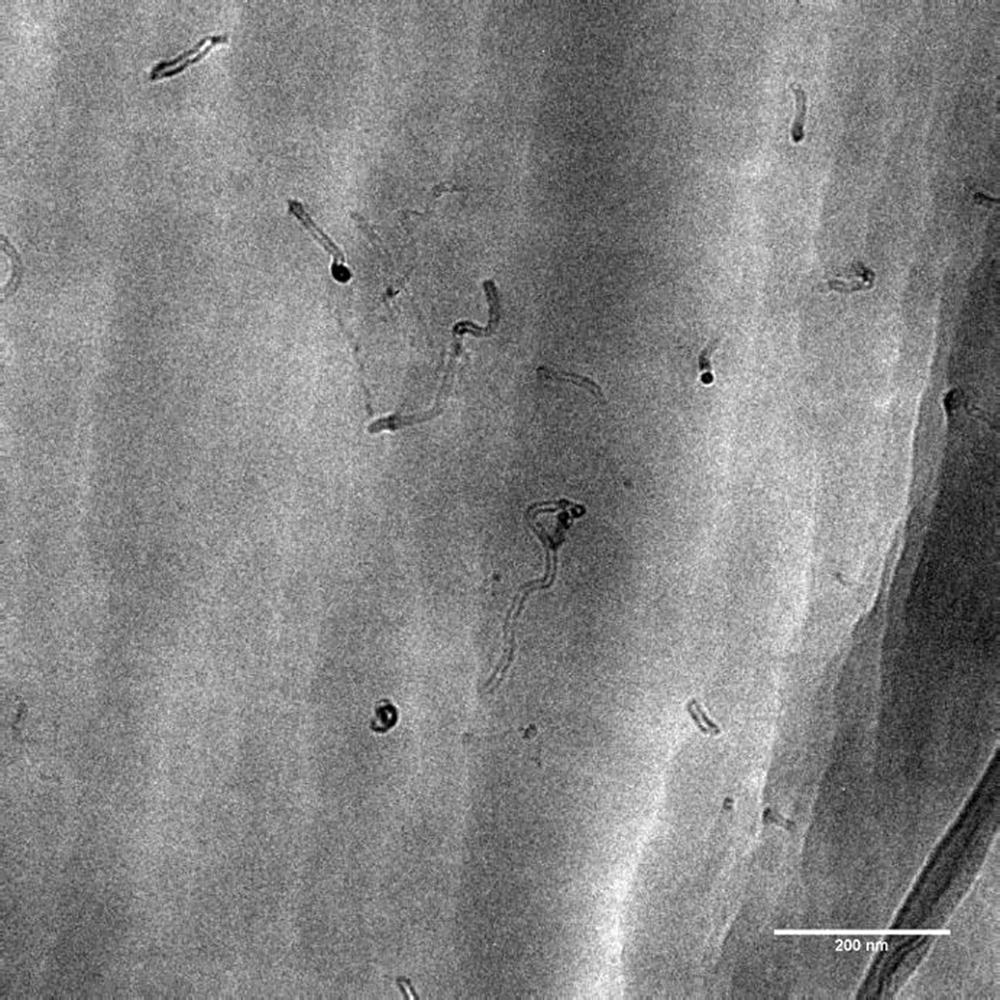
TEM image of the SWNTs dispersion in epoxy based Proposed Multi-Stage method.
4 Conclusion
In this paper, a new, univariate and improved approach is presented for dispersion of nanoparticles in epoxy resin. There are several methods for dispersion of nanoparticles in polymers. In these methods, probe sonication is the most accepted method for this matter. But based on the previous researches, it is shown that the quality and performance of this method depends on several parameters. Also, the process of probe sonication may cause some defects on polymeric chains and nanoparticles structures. Subsequently, optimization of this method is not easy. Because of this limitations and defects, a univariate, improved and Multi-Stage approach is present that has not dependence on several parameters and it is safer than traditional method (probe sonication).
In order to verify the improved method, a comparison between the traditional method and the new Multi-Stage method base on functionalization of CNTs, mechanical dispersion and ultra-sonication (bath and probe) is presented. For this comparison, several tests such as SEM and viscosity are used for carboxylated SWCNT/epoxy. Note that, before these Comparative tests, the carboxylic groups remain on the surface of SWNTs were detected by FT-IR spectra. The results of SEM indicate that, in dispersed suspension with the new Multi-Stage method, longer carbon nanotubes are observed with the lower breakage than the traditional method. Also, Viscosity test shows that in dispersion base on the presented method, the viscosity of the mixture is raised and then levels. But, in the traditional method, the viscosity gradually raises and then decreases by passing the sonication's time. This decreasing trend is because of the polymeric chains scission and also shortening of SWNTs. These defects are because of the high level of energy on the tip of the probe. This rising and falling trend is reported by several researchers in case of CNTs and other nanoparticles. Comparison between the results of two mentioned method shows that, in the proposed Multi-Stage method, the maximum viscosity is about 20% higher than the traditional method. In the following, other samples, including different kinds and weight fractions of nanoparticles (SWNT/epoxy (0.25 wt%) and Graphene Oxide (GO)/epoxy (0.1 wt% & 0.25 wt%)) are tested and the results conform to the predictions and expectations. Also for validation of the results, a mechanical bending test is carried out on the pure epoxy resin and SWNT-c/epoxy (0.1 wt%) samples. The results of this test are compared with the previous researches. This Comparison shows that the new Multi-Stage process is not only as effective as the traditional method but also in some cases is preferable. Finally, a TEM test is used to investigate the dispersion status of SWNT based on the proposed multistage method. Based on this test, fully dispersion of SWNTs can be seen.
References
- Polymers with aligned carbon nanotubes, active composite materials. Polymer. 2008;49:3841-3854.
- [Google Scholar]
- Reinforcement of multiwalled carbon nanotubes/natural rubber nanocomposite prepared by latex technology. J. Trop. For. Sci.. 2012;8:131-140.
- [Google Scholar]
- Effect of dispersion method on tribological properties of carbon nanotube reinforced epoxy resin composites. Polym. Test.. 2007;26:351-360.
- [Google Scholar]
- Fabrication of multi-walled carbon nanotube/vinyl ester nanocomposites dispersion and stabilization. Def. Diff. Forum.. 2011;312(315):460-465.
- [Google Scholar]
- Carbon nanotube reinforced epoxy-composites, enhanced stiffness and fracture toughness at low nanotube content. Compos. Sci. Technol.. 2004;64:2363-2371.
- [Google Scholar]
- Time-dependent study of the exfoliation process of carbon nanotubes in aqueous dispersions by using UV visible spectroscopy. Anal. Chem.. 2005;77:5135-5139.
- [Google Scholar]
- Grossiord, N., 2007. A latex-based concept for making carbon nanotube/polymer nanocomposites. Ph.D. Dissertation, Eindhoven, Technische Universiteit Eindhoven, Netherlands.
- Functionalization of single-walled carbon nanotubes. Angew. Chem. Int. Ed.. 2002;41:1853-1859.
- [Google Scholar]
- Predicting young’s modulus of CNT-reinforced polymers. Comput. Mater. Sci.. 2015;108:34-37.
- [Google Scholar]
- Investigating the effect of interphase and surrounding resin on carbon nanotube free vibration behavior. Phys. E. 2015;68:42-52.
- [Google Scholar]
- Insight into the mechanism of sidewall functionalization of single-walled nanotubes, an STM study. Chem. Phys. Lett.. 1999;313:445-450.
- [Google Scholar]
- The effect of solvent choice on the mechanical properties of carbon nanotube-polymer composites. Compos. Sci. Technol.. 2007;67:3158-3167.
- [Google Scholar]
- Effect of ultrasonic wave on the degradation of polypropylene melt and morphology of its blend with polystyrene. Polymer. 2005;43:2585-2589.
- [Google Scholar]
- Mechanical and electrical properties of natural rubber and nitrile rubber blends filled with multi-wall carbon nanotube, effect of preparation methods. Polym. Test. N 2013:731-738.
- [Google Scholar]
- Correlations between percolation threshold, dispersion state and aspect ratio of carbon nanotube. Adv. Funct. Mater.. 2007;17:3207-3215.
- [Google Scholar]
- Investigation of the dispersion process of SWNTs/SC-15 epoxy resin nanocomposites. Mater. Sci. Eng. A.. 2004;385:175-181.
- [Google Scholar]
- Dispersion and functionalization of carbon nanotubes for polymer-basedN, a review. Compos. Part. A Appl. Sci. Manuf.. 2010;41:1345-1367.
- [Google Scholar]
- Dispersion of single wall carbon nanotubes by in situ polymerization under sonication. Chem. Phys. Lett.. 2002;364:303-308.
- [Google Scholar]
- Mechanical and dilatometric properties of carboxylated SWCNT/epoxy composites, effects of the dispersion in the resin and in the hardener. J. Reinf. Plast. Compos.. 2010;29:524-530.
- [Google Scholar]
- Development of a dispersion process for carbon nanotubes in an epoxy matrix and the resulting electrical properties. Polymer. 1999;40:5967-5971.
- [Google Scholar]
- Mechanical flocculation in flowing fiber suspensions. Phys. Rev. Lett.. 2000;84:290-293.
- [Google Scholar]
- A combined micromechanical-numerical model to simulate shear behavior of carbon nanofiber/epoxy nanocomposites. Mater. Des.. 2015;67:531-537.
- [Google Scholar]
- Effect of sonication on thermo-mechanical properties of epoxy nanocomposites with carboxylated-SWNT. Mater. Sci. Eng. A 2009:57-62.
- [Google Scholar]
- Tough nanocomposites, the role of carbon nanotube type. Nano Lett.. 2009;9:1423-1426.
- [Google Scholar]
- Direct evidence of main-chain scissions induced by ultrasonic irradiation of benzene solutions of polymers. Cheml. Phys. Lett.. 1980;73:178-180.
- [Google Scholar]
- Processing-structure-multi-functional property relationship in carbon nanotube/epoxy composites. Carbon. 2006;44:3022-3029.
- [Google Scholar]
- Processing-structure-property relationships of SWNT-epoxy composites prepared using ionic liquids. Comp. Part. A Appl. Sci. Manuf.. 2015;73:269-276.
- [Google Scholar]
- Improving the dispersion and integration of single-walled carbon nanotubes in epoxy composites through functionalization. Nano Lett.. 2003;3:1107-1113.
- [Google Scholar]







